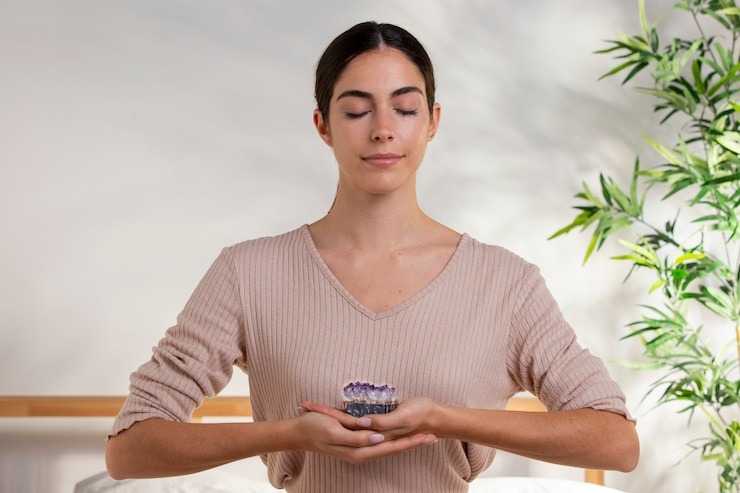Starting your day with purpose can completely change how you move through the world. I speak from experience. I used to wake up, check my phone, and rush through breakfast before diving into work.
Those mornings often left me feeling scattered and reactive. But when I began to integrate mindful morning practices—even just 10 to 15 minutes—I noticed a powerful shift. My mood stabilized, my focus sharpened, and I felt more in tune with what mattered.
This guide is about small steps that help you greet the day with clarity and calm.
Key Highlights
- A mindful morning helps you feel grounded, focused, and ready for the day.
- Even simple practices like breathwork or stretching can create a sense of peace.
- Preparing a dedicated space makes mindful habits easier to stick with.
- Your morning routine should be flexible and personal to your needs.
- Building a mindful start encourages emotional balance and resilience.

Why A Calm Start Shapes Your Whole Day
If you wake up and immediately rush into tasks, emails, or news, you set a tone of urgency that can linger. The mind stays in reaction mode. By contrast, starting the day gently encourages your nervous system to remain steady. Think of it as giving yourself a head start against stress.
Mindful morning routines have been linked to lower cortisol levels, improved concentration, and a better mood throughout the day. This isn’t just theory—research published in Mindfulness journal shows that even short periods of morning mindfulness can reduce anxiety and improve cognitive performance.
And truly, you’ll notice the difference yourself: less tension in your shoulders, more patience, and a greater sense of purpose as you move through the hours ahead.
Make Your Space Support Your Practice
Your environment plays a quiet but powerful role in how you feel each morning. You don’t need a meditation room or a fancy setup. Even a small space can serve as a sanctuary.
I like to clear a corner near a window, lay down a mat or cushion, and place a few items that help me feel centered: a candle, a small plant, or a favorite mug.
You might also prepare practical tools ahead of time so you’re not scrambling. For example, if part of your mindful ritual involves herbs, setting out a weed grinder the night before ensures you can move through your routine without unnecessary distractions.
The goal is ease—a space that invites you to slow down and connect with yourself.
Gentle Breathwork for Inner Stillness
Conscious breathing is one of the simplest ways to center yourself, yet it’s easy to overlook. Breath anchors us to the present moment, gently quieting the mind and relaxing the body.
Here’s one of my favorite ways to begin:
- Sit comfortably with your spine upright.
- Close your eyes or soften your gaze.
- Inhale slowly through your nose, counting to four.
- Hold your breath gently for a count of three.
- Exhale fully through your mouth, counting to six.
- Repeat for five cycles, letting each exhale release tension.
You can do this in bed, at your desk, or even standing at the window watching the sunrise. It’s not about technique; it’s about presence.
Stretching the Body, Soothing the Mind
Movement is a beautiful way to wake up the body and settle the mind. You don’t need to commit to a full yoga session (unless you want to). Even five minutes of gentle stretching helps increase circulation, ease stiffness, and create a sense of lightness.
A few simple stretches to try:
- Neck rolls: Slowly roll your head in gentle circles to release tension.
- Side body stretch: Lift one arm overhead and lean to the opposite side.
- Seated twist: Sit cross-legged and gently twist to each side.
- Forward fold: Stand or sit and fold forward, letting the spine lengthen.
Pay attention to how each stretch feels. The point isn’t flexibility—it’s awareness and care for your body.
Nourishment as a Mindful Act
Breakfast often becomes another task to rush through, but it can be a moment of grounding. Preparing your first meal of the day slowly and with attention transforms it into a ritual.
Even if it’s just making tea or slicing fruit, notice the colors, textures, and scents. Pause between bites. Chew fully. Let yourself taste the food.
If you enjoy herbal blends or incorporate other plant-based rituals, take a moment to engage with them mindfully. Grinding herbs, brewing tea, or simply holding a warm mug can all be small anchors that help you stay present.
Journaling for Clarity and Intention
Writing in the morning offers a gentle way to clear mental clutter and set your focus. This doesn’t need to be complicated. A few ideas:
- Jot down three things you’re grateful for.
- Write one word that reflects how you want to feel
- Note any thoughts or dreams that linger from the night.
- Set a simple intention: I choose patience, I welcome joy, I will breathe deeply.
You don’t need perfect grammar or long entries. Let it be a space for honesty and release.

Building a Routine That Feels Right for You
There’s no single formula for a mindful morning. The best routine is one that fits your life and nourishes your spirit. Maybe your practice lasts 30 minutes. Maybe it’s five minutes of deep breathing before coffee. What matters is that you create space for stillness and connection.
Here’s how you might shape a simple mindful morning flow:
| Practice | Duration | Why It Helps |
| Breathwork | 3-5 min | Calms the mind, reduces stress |
| Gentle Stretch | 5-10 min | Awakens the body, improves circulation |
| Tea or breakfast prep | 5 min | Encourages presence, soothes digestion |
| Journaling | 5 min | Clears mental clutter, sets intention |
Adjust this as needed. Some mornings will be quieter than others—and that’s okay. Mindfulness is about meeting yourself where you are, with compassion.
Final Thoughts
Mindful mornings are not about adding pressure or creating another item on your to-do list. They’re about offering yourself a gift: a few moments of peace before the world gets loud.
When you start the day with intention, it changes how you relate to yourself, to others, and to whatever challenges may come.
Over time, these small practices add up to something powerful—a life lived with greater awareness, ease, and kindness.
If you’d like, I can help suggest a printable checklist or a guide to designing your own mindful space. Just let me know!

